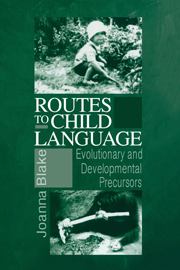Book contents
- Frontmatter
- Contents
- Preface
- 1 Prelinguistic Vocalizations
- 2 Sound–Meaning Correspondences
- 3 Communicative Gestures
- 4 Symbolic Gestures and Symbolic Play
- 5 Tool Use and Object Concept
- 6 Representation in Human Infants
- 7 Memory in Nonhuman Primates and Young Children
- 8 Origins of Language
- 9 Recapitulation
- References
- Index
2 - Sound–Meaning Correspondences
Published online by Cambridge University Press: 12 January 2010
- Frontmatter
- Contents
- Preface
- 1 Prelinguistic Vocalizations
- 2 Sound–Meaning Correspondences
- 3 Communicative Gestures
- 4 Symbolic Gestures and Symbolic Play
- 5 Tool Use and Object Concept
- 6 Representation in Human Infants
- 7 Memory in Nonhuman Primates and Young Children
- 8 Origins of Language
- 9 Recapitulation
- References
- Index
Summary
The issue of what meaning is and how to define it has occupied philosophers, linguists, and psycholinguists for a very long time. Linguists limit meaning to word meaning, or what Halliday (1975) has termed lexicosemantic. Halliday's pioneering observations of his son's prelinguistic vocalizations, however, revealed that Nigel had a functional system of meaning prior to adopting recognizable adult-modeled words. That is to say, he used many nonword expressions repeatedly with the same functional content relevant to particular situations. These early expression–content relations were grouped into categories that anticipated the later semantic system of the linguistic period. Halliday termed the early system bistratal, with meaning being directly mapped onto sound, in contrast to the later tristratal system in which sound and meaning are related via syntax. He stressed the continuity between the two systems, thus extending the ideas expressed in the previous chapter about phonetic continuity between babbling and language to continuity on the semantic plane as well. Although other observers have presented illustrations of “phonetically consistent forms” (Dore, Franklin, Miller, & Ramer, 1976) or “clusters of sounds exhibiting a functional content” (Gillis & De Schutter, 1986), it is only with Halliday's extensive and detailed observations of Nigel that a clear case has been made for a prelinguistic semantic system.
Similar efforts are currently ongoing among observers of nonhuman primates. These researchers have been concerned with the degree to which animal signals in the field can be viewed as referential, in that a certain signal transmits a particular meaning to conspecifics whereas other signals transmit a different meaning.
- Type
- Chapter
- Information
- Routes to Child LanguageEvolutionary and Developmental Precursors, pp. 42 - 77Publisher: Cambridge University PressPrint publication year: 2000



